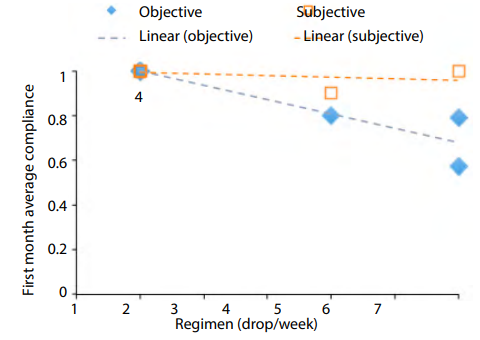1、Attebo K, Mitchell P, Cumming R, et al. Prevalence and causes of amblyopia in an adult population. Ophthalmology 1998;105:154-9.
2、Schmidt P, Maguire M, Dobson V, et al. Comparison of preschool vision screening tests as administered by licensed eye care professionals in the Vision In Preschoolers Study.
Ophthalmology 2004;111:637-50.
3、Pediatric Eye Disease Investigator Group. A randomized trial of atropine vs. patching for treatment of moderate amblyopia in children. Arch Ophthalmol 2002;120:268-78.
4、Repka MX, Cotter SA, Beck RW, et al. A randomized trial of atropine regimens for treatment of moderate amblyopia in children. Ophthalmology 2004;111:2076-85.
5、Scheiman MM, Hertle RW, Kraker RT, et al. Patching vs atropine to treat amblyopia in children aged 7 to 12 years: a randomized trial. Arch Ophthalmol 2008;126:1634-42.
6、Pediatric Eye Disease Investigator Group. Pharmacological plus optical penalization treatment for amblyopia: results of a randomized trial. Arch Ophthalmol 2009;127:22-30.
7、Pediatric Eye Disease Investigator Group. The course of moderate amblyopia treated with atropine in children: experience of the amblyopia treatment study. Am J Ophthalmol 2003;136:630-9.
8、Pediatric Eye Disease Investigator Group, Repka MX, Kraker RT, et al. A randomized trial of atropine vs patching for treatment of moderate amblyopia: follow-up at age 10 years. Arch Ophthalmol 2008;126:1039-44.
9、Holmes JM, Beck RW, Kraker RT, et al. Impact of patching and atropine treatment on the child and family in the amblyopia treatment study. Arch Ophthalmol 2003;121:1625-32.
10、Felius J, Chandler DL, Holmes JM, et al. Evaluating the burden of amblyopia treatment from the parent and child's perspective. J AAPOS 2010;14:389-95.
11、Penetar DM, Beatrice ES. Eff ects of atropine on human pursuit tracking performance. Aviat Space Environ Med 1986;57:654-8.
12、Penetar DM, Haegerstrom-Portnoy G, Jones RT. Combined atropine and 2-PAM Cl eff ects on tracking performance and visual, physiological, and psychological functions. Aviat Space Environ Med 1988;59:1125-32.
13、Smith%20M.%20Atropine%20and%20Down's%20syndrome%3A%20dangerous%20mix%3F%20Nursing%201994%3B24%3A6.
14、Sayner R, Carpenter DM, Blalock SJ, et al. Accuracy of Patient-reported Adherence to Glaucoma Medications on a Visual Analog Scale Compared With Electronic Monitors. Clin Ther 2015;37:1975-85.
15、El Alili M, Vrijens B, Demonceau J, et al. A scoping review of studies comparing the medication event monitoring system (MEMS) with alternative methods for measuring medication adherence. Br J Clin Pharmacol 2016;82:268-79.
16、Tejedor J, Ogallar C. Comparative efff cacy of penalization methods in moderate to mild amblyopia. Am J Ophthalmol 2008;145:562-9.
17、Foley-Nolan A, McCann A, O'Keefe M. Atropine penalisation versus occlusion as the primary treatment for amblyopia. Br J Ophthalmol 1997;81:54-7.
18、Holmes JM, Beck RW, Repka MX, et al. The amblyopia treatment study visual acuity testing protocol. Arch Ophthalmol 2001;119:1345-53.
19、Pediatric Eye Disease Investigator Group. The clinical profile of moderate amblyopia in children younger than 7 years. Arch Ophthalmol 2002;120:281-7.
20、Freedman RB, Jones SK, Lin A, et al. Inff uence of parental health literacy and dosing responsibility on pediatric glaucoma medication adherence. Arch Ophthalmol 2012;130:306-11.
21、Jin YP, Chow AH, Colpa L, et al. Clinical translation of recommendations from randomized clinical trials on patching regimen for amblyopia. Ophthalmology 2013;120:657-62.
22、Stewart CE, Moseley MJ, Fielder AR. Amblyopia therapy: an update. Strabismus 2011;19:91-8.
23、Repka MX, Kraker RT, Beck RW, et al. Treatment of severe amblyopia with weekend atropine: results from 2 randomized clinical trials. J AAPOS 2009;13:258-63.
24、Matta N, Silbert DI. Eff ects of atropine on the accommodative system: parameters to consider in its use for penalization treatment of amblyopia. Binocul Vis Strabolog Q Simms Romano 2013;28:39-44.
25、Hainline BC, Sprunger DC, Plager DA, et al. Reverse amblyopia with atropine treatment. Binocul Vis Strabismus Q 2009;24:25-31.
26、Holmes JM, Beck RW, Kraker RT, et al. Risk of amblyopia recurrence after cessation of treatment. J AAPOS 2004;8:420-8.






